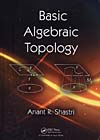- About MAA
- Membership
- MAA Publications
- Periodicals
- Blogs
- MAA Book Series
- MAA Press (an imprint of the AMS)
- MAA Notes
- MAA Reviews
- Mathematical Communication
- Information for Libraries
- Author Resources
- Advertise with MAA
- Meetings
- Competitions
- Programs
- Communities
- MAA Sections
- SIGMAA
- MAA Connect
- Students
- MAA Awards
- Awards Booklets
- Writing Awards
- Teaching Awards
- Service Awards
- Research Awards
- Lecture Awards
- Putnam Competition Individual and Team Winners
- D. E. Shaw Group AMC 8 Awards & Certificates
- Maryam Mirzakhani AMC 10 A Awards & Certificates
- Two Sigma AMC 10 B Awards & Certificates
- Jane Street AMC 12 A Awards & Certificates
- Akamai AMC 12 B Awards & Certificates
- High School Teachers
- News
You are here
Basic Algebraic Topology

Publisher:
Chapman & Hall/CRC
Publication Date:
2013
Number of Pages:
535
Format:
Hardcover
Price:
89.95
ISBN:
9781466562431
Category:
Textbook
[Reviewed by , on ]
Michael Berg
02/27/2014
The book under review is a somewhat compact (if you’ll pardon the expression) and fast-paced treatment of algebraic topology for an audience of beginning graduate students. The book is at once purposely narrow and ambitious in its scope — perhaps this juggling of apparently opposite objectives cannot be avoided when it comes to presenting newcomers with the huge and sophisticated tool-kit of this major branch of modern mathematics.
Shastri characterizes algebraic topology as a set of answers, so to speak, to the basic question “when are two topological spaces homeomorphic?”, a fundamental theme which has indeed given rise to a panoply of topological invariants and marvelous constructions that transcend the boundaries of topology. These have led to such sweeping “philosophies” as the method of categories and functors, again spilling over into mathematics at large. The according impact of algebraic topology in the broadest sense is really best conveyed in Jean Dieudonné’s titanic History of Algebraic and Differential Topology (1900–1960).
But what of Shastri’s book? Well, it’s all there, in essentially historical order. After developing the basics, including the fundamental group, relative homotopy, cofibrations and fibrations and a bit of category theory, the march is on: simplicial complexes, covering spaces, homology (especially singular homology), manifolds and vector bundles, the universal coefficient theorem, cohomology, and then a focus on manifolds and de Rham cohomology. It’s certainly something of a crescendo, and I should say that, in rough terms, this collectively makes for a good first semester curriculum. Thereafter Shastri hits sheaf cohomology (Serre’s Faisceaux Algébriques Cohérents, not Grothendieck’s
So does Shastri pull it off? Does he succeed in presenting a viable text for a year’s course in algebraic topology covering such a wealth of material? I think he does. Indeed, treated right, Basic Algebraic Topology will serve well as both a successful class-room tool and a source for serious self-study. But be forewarned: Shastri wastes no time, and there is a lot of ground to cover
All in all, I think Basic Algebraic Topology is a good graduate text: the book is well-written and there are many well-chosen examples and a decent number of exercises. It meets its ambitious goals and should succeed in leading a lot of solid graduate students, as well as working mathematicians from other specialties seeking to learn this subject, deeper and deeper into its workings and subtleties.
Michael Berg is Professor of Mathematics at Loyola Marymount University in Los Angeles, CA.
Introduction
The Basic Problem
Fundamental Group
Function Spaces and Quotient Spaces
Relative Homotopy
Some Typical Constructions
Cofibrations
Fibrations
Categories and Functors
Cell Complexes and Simplicial Complexes
Basics of Convex Polytopes
Cell Complexes
Product of Cell Complexes
Homotopical Aspects
Cellular Maps
Abstract Simplicial Complexes
Geometric Realization of Simplicial Complexes
Barycentric Subdivision
Simplicial Approximation
Links and Stars
Covering Spaces and Fundamental Group
Basic Definitions
Lifting Properties
Relation with the Fundamental Group
Classification of Covering Projections
Group Action
Pushouts and Free Products
Seifert–van Kampen Theorem
Applications
Homology Groups
Basic Homological Algebra
Singular Homology Groups
Construction of Some Other Homology Groups
Some Applications of Homology
Relation between π1 and H1
All Postponed Proofs
Topology of Manifolds
Set Topological Aspects
Triangulation of Manifolds
Classification of Surfaces
Basics of Vector Bundles
Universal Coefficient Theorem for Homology
Method of Acyclic Models
Homology with Coefficients: The Tor Functor
Kűnneth Formula
Cohomology
Cochain Complexes
Universal Coefficient Theorem for Cohomology
Products in Cohomology
Some Computations
Cohomology Operations; Steenrod Squares
Homology of Manifolds
Orientability
Duality Theorems
Some Applications
de Rham Cohomology
Cohomology of Sheaves
Sheaves
Injective Sheaves and Resolutions
Cohomology of Sheaves
Čech Cohomology
Homotopy Theory
H-Spaces and H0-Spaces
Higher Homotopy Groups
Change of Base Point
The Hurewicz Isomorphism
Obstruction Theory
Homotopy Extension and Classification
Eilenberg–Mac Lane Spaces
Moore–Postnikov Decomposition
Computation with Lie Groups and Their Quotients
Homology with Local Coefficients
Homology of Fibre Spaces
Generalities about Fibrations
Thom Isomorphism Theorem
Fibrations over Suspensions
Cohomology of Classical Groups
Characteristic Classes
Orientation and Euler Class
Construction of Steifel–Whitney Classes and Chern Classes
Fundamental Properties
Splitting Principle and Uniqueness
Complex Bundles and Pontrjagin Classes
Spectral Sequences
Warm-Up
Exact Couples
Algebra of Spectral Sequences
Leray–Serre Spectral Sequence
Some Immediate Applications
Transgression
Cohomology Spectral Sequences
Serre Classes
Homotopy Groups of Spheres
Hints and Solutions
Bibliography
Index
- Log in to post comments




